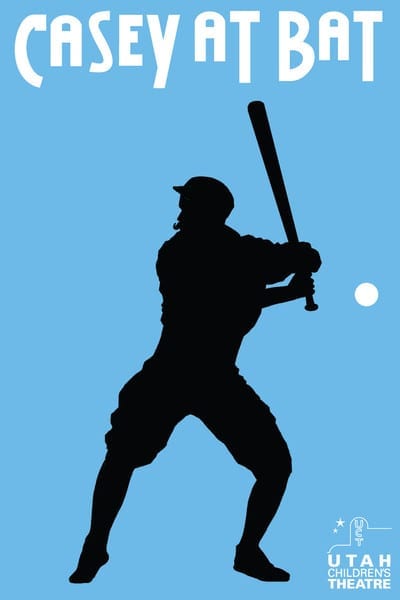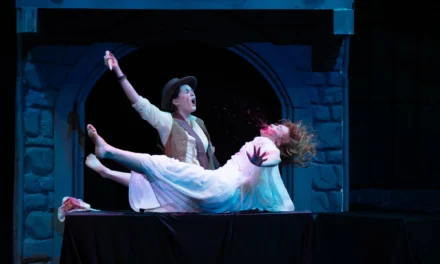SOUTH SALT LAKE — As an elementary school teacher, I frequently get the opportunity to share with children classic literature including Earnest Thayer‘s 1888 poem, “Casey at the Bat.” Thayer’s poem explores the fine line between confidence and pride as they are forming the core values that shape their personalities. Matthew Windham‘s theatrical adaptation, Casey at Bat, adds an interesting back story leading up to the pivotal moment in which the prideful hometown hero chooses to let the first two pitches fly right past him. In Casey at Bat, Casey (Bryson Dumas) battles several vices beyond his pride, including selfishness and disloyalty. In contrast, Windham’s adaptation provides a real hero in Noodles Watson (Landon Krazsek). Ultimately getting the win, the girls, and the label as a “real champion,” Noodles Watson becomes ultimate example of being a team player.
Mirroring the show’s message of team unity, this Utah Children’s Theatre (UCT) cast worked together seamlessly. Despite many actors and actresses required to play multiple characters—even switching teams and character names discreetly on stage during Act II’s baseball game—the pace of the show never seemed to be interrupted. Throughout the production, each character was distinctly different from others onstage, even when acting in ensemble groups. For example, a group of children from Frogtown appeared together on stage, frequently in the same group. It was impressive to see the distinct characters of Amelia Peyton (Sofia Rahaniotis), Sammy Peyton (Taylor Sachs), Charlie (Cole Lawson) and Sinclair (Nate Ginsberg) as they each added a unique dynamic to the group. I particularly enjoyed Rahaniotis’s performance as she admired Noodles Watson in a simultaneously tomboyish and dew-eyed manner. Allison Frogh and Adrienne Eror, as Ginger and Abigail respectively, proved to be another great pair. Each was tasked to portray a girl smitten with the handsome and successful Casey. The script did little to differentiate the characters, but Frogh and Eror each brought something totally different to the stage. I really enjoyed watching the different walks and stances each actress had developed.
Physical humor was essential to the comedic success of this show for young audiences. In complete commitment to throwing themselves all over the stage in pursuit of the laugh, Kracsek as Noodles Watson, Sean Newbold as Jake Keene, and Todd Tharp as Earl Spade stood out in the crowd. I found myself watching the kids in the audience who leaned out of their seats trying to see the giant catfish on the end of Noodles’s fishing line, despite both the line and the fish being pantomimed. Certainly, with as much as Noodles physically exerted himself, there must have been a real fish on the end of that line! Newbold’s and Tharp’s twitches, twirls, and convulsions as each battled with the side effects of a questionable performance enhancing elixir they’d tried came frequently, comically interrupting a variety of conversations. As both playwright and director, Windham pulled all the right strings to entertain the young target audience.
But it wasn’t just these three who physically committed to telling the story. Much of the second act took place during the big game between Mudville and Frogtown, with the details of several innings unfurling in full view of the audience. Admittedly not a huge fan of baseball, I was far more entertained by this game, played in pantomime with no real ball, than I tend to be seated in the stands of an actual game. For this, credit should be given to each ball player (Dumas, Froh, Kraczek, Tharp, Paul Chaus, Jacob Harmon, Zackery Western, Lawson, and Patrick Boyd) for their accurate athletic movements and for the natural banter that remained consistent throughout the game. In addition, different baseball bats created the appropriate sound for either a hit or a miss, which added to the realistic baseball atmosphere (properties uncredited). Finally, the simple set and lighting (by James B. Parker) and costuming (by Christina Wilson) were ideal for an afternoon unplugged. The simplicity of the visual designs created the perfect backdrop against which to expand this classic poem.
As I attended this production I couldn’t escape the Utah Children’s Theatre’s focus on education. With shows geared toward children ages four and up, the UCT packed theatre etiquette, audience participation, and values education into a very energetic 75 minutes. After receiving instruction on how to respectfully appreciate the funny moments on stage, the audience was asked to participate in “the wave,” which was acknowledged as not being generally acceptable at most productions. Intermission included opportunities for young audience members to get out of their seats and practice their baseball skills. Several kids got a chance to bat, and both adults and children participated in throwing practice. There was even a music lesson as the audience practiced singing “Take Me Out to the Ballgame,” which paired perfectly with the Cracker Jacks for sale at the concession stand. In truth, my only regret was of not bringing the whole family—or better yet, my son’s whole baseball team.






